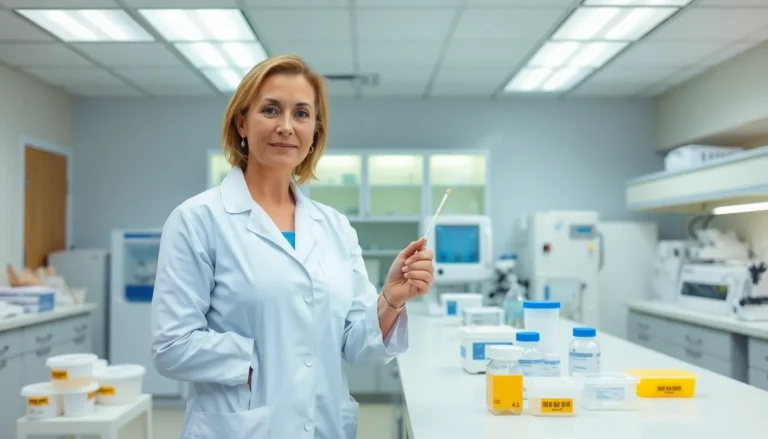Vaginal culture might sound like a fancy term reserved for a science lab, but it’s actually a fascinating peek into the world of women’s health. Think of it as a backstage pass to understanding the unique ecosystem that thrives in the vagina. This tiny yet mighty area is home to a diverse community of bacteria, and knowing how to keep it balanced can lead to better health and well-being.
Table of Contents
ToggleOverview Of Vaginal Culture
Vaginal culture serves as a method to identify and analyze the microorganisms inhabiting the vagina. Microbiologists conduct this analysis using samples obtained from the vaginal environment. Depending on the specific bacteria, the culture can reveal important details about vaginal health.
A balanced vaginal microbiome contains predominantly Lactobacillus species, which help maintain an acidic environment. An imbalance can lead to conditions such as bacterial vaginosis or yeast infections. Recognizing the signs of imbalance proves essential for proactive health management.
Clinicians often recommend vaginal cultures when a patient presents symptoms such as unusual discharge or odor. Results from these cultures help guide appropriate treatment options. Testing can take place at healthcare facilities where specialists examine the sample in a laboratory setting.
Certain factors impact vaginal flora, including hormonal changes, sexual activity, and antibiotic use. Maintaining a healthy lifestyle also supports optimal vaginal health. Proper diet, hydration, and regular gynecological check-ups contribute to sustaining a balanced microbiome.
Understanding vaginal culture assists in addressing women’s health concerns effectively. Those seeking insights into their vaginal health can pursue such testing to inform their decisions. Trusting healthcare professionals to interpret culture results ensures actionable strategies for maintaining well-being.
Types Of Vaginal Culture
Vaginal cultures can be categorized into aerobic and anaerobic types, each serving a distinct purpose in analyzing vaginal health.
Aerobic Culture
Aerobic culture utilizes conditions that promote the growth of organisms requiring oxygen. This method is valuable for identifying aerobic bacteria such as Gardnerella and E.coli. It traditionally employs a sample collection from the vaginal ecosystem, which is then placed on culture media that supports aerobic organisms’ growth. Clinicians often recommend aerobic cultures when patients present symptoms like unusual discharge linked to infections. The results can guide appropriate antibiotic treatments tailored to specific bacterial infections.
Anaerobic Culture
Anaerobic culture focuses on microorganisms that thrive in oxygen-free environments. This type is essential for detecting bacteria that may contribute to conditions such as bacterial vaginosis. Specimens undergo collection and placement in special media that prevents exposure to oxygen, enabling the growth of anaerobic bacteria like Prevotella and Peptostreptococcus. Symptoms prompting this culture include persistent odors or discomfort linked to vaginal infections. Identifying these anaerobic bacteria aids in developing effective treatment plans, ensuring patients receive the correct care for maintaining vaginal health.
Importance Of Vaginal Culture
Vaginal culture plays a crucial role in women’s health management. It allows clinicians to identify infections and assess microbial balance within the vagina.
Diagnosis Of Infections
Diagnosis of infections becomes precise with vaginal cultures. These cultures enable detection of harmful bacteria, such as Gardnerella and E. coli, particularly when symptoms like unusual discharge or foul odor occur. Conducting aerobic cultures reveals organisms requiring oxygen, which assists in targeting specific infections. When anaerobic cultures are performed, they focus on bacteria thriving in oxygen-free conditions. Persistent symptoms often prompt these diagnostics, leading to timely and effective treatments. Understanding the results enhances the ability to address health issues that may arise from infections.
Assessing Microbiome Health
Assessing microbiome health provides insight into overall vaginal well-being. Monitoring the balance of Lactobacillus species maintains a healthy environment, which is essential for preventing conditions like bacterial vaginosis and yeast infections. Regular vaginal cultures highlight changes in microbial composition, allowing for adjustments in healthcare strategies. Health issues may emerge from factors such as hormonal fluctuations or antibiotic use, affecting the vaginal ecosystem. Being proactive about microbiome health helps individuals make informed decisions. Regular testing supports a deeper understanding of one’s health and encourages discussions with healthcare providers for optimal care.
Procedure For Vaginal Culture
Vaginal culture involves specific steps to ensure accurate results. The process starts with careful sample collection and continues with detailed laboratory processing.
Sample Collection
Clinicians gather vaginal samples using sterile swabs, ensuring minimal contamination. It’s essential for patients to follow guidelines before the procedure, such as avoiding sexual intercourse and douching for at least 24 hours. The collected sample typically comes from the posterior fornix, which offers a representative mix of microorganisms. Samples need to be promptly transported to the laboratory for analysis. Proper timing during the menstrual cycle may enhance the effectiveness of the culture.
Laboratory Processing
During laboratory processing, microbiologists apply techniques to culture the sample in appropriate environments. For aerobic cultures, swabs are placed in media that support bacteria thriving in oxygen-rich settings. Anaerobic cultures require different mediums designed for growth without oxygen, allowing the detection of specific pathogens. Identification of microorganisms follows, often involving microscopy, biochemical tests, or molecular techniques. Results usually emerge within 48 to 72 hours, providing critical insights into a patient’s vaginal health status. These evaluations lead to tailored treatment options based on the identified pathogens.
Interpretation Of Results
Interpreting vaginal culture results involves understanding the different microorganisms present in the vaginal environment. This process provides insights into a woman’s vaginal health and aids in the diagnosis of potential infections.
Common Findings
Common findings in vaginal cultures include the presence of Lactobacillus species, which signify a healthy microbiome. A predominance of these bacteria indicates an acidic environment, crucial for preventing infections. Conversely, high levels of Gardnerella, E. coli, or other pathogens can suggest an imbalance. Such imbalances often correlate with conditions like bacterial vaginosis or yeast infections. Clinicians analyze these cultures to understand the overall microbial composition and gauge how it affects vaginal health.
Identifying Pathogens
Identifying pathogens through vaginal culture entails recognizing harmful bacteria that can cause infections. Microbiologists typically isolate and categorize these organisms based on their growth characteristics. Bacteria such as Trichomonas, Gardnerella, and various anaerobes frequently emerge in cultures associated with symptoms like unusual discharge or odor. Determining the specific pathogens allows clinicians to tailor treatment plans aimed at restoring the vaginal microbiome’s balance, addressing any detected infections effectively.
Vaginal culture plays a pivotal role in understanding and maintaining women’s health. By identifying the microorganisms present in the vaginal ecosystem, it helps clinicians diagnose infections and address imbalances effectively. Regular testing and open discussions with healthcare providers empower women to take charge of their vaginal health. With knowledge about the importance of a balanced microbiome, women can make informed decisions and seek timely interventions. This proactive approach not only enhances overall well-being but also fosters a deeper understanding of individual health needs. Embracing vaginal culture as a routine aspect of healthcare can lead to healthier outcomes and improved quality of life.



